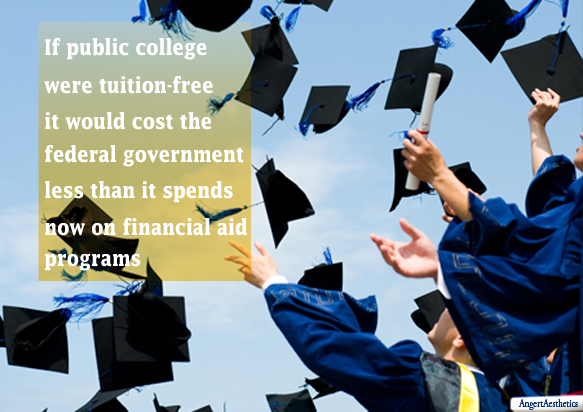Mister President, we thank you for addressing the need to expand college opportunities. As you noted, currently, inequity and inequality are replete. “
The First Lady observed, “These kids are smart. They will notice if we’re not holding up our end of the bargain.” Millions of our young have noticed! We did not honor our commitment.
It is we who made a promise and posited the pledge; this is the land of opportunity. In American you can dream. Together we can do. Success is not solely for select philanthropic few and other “foundations.”. Nor, Mister Obama, are these individuals the answer to how we might expand college opportunities. There is a solution that honors the “bargain”…
Here’s Exactly How Much the Government Would Have to Spend to Make Public College Tuition-Free
A mere $62.6 billion dollars!
According to new Department of Education data, that’s how much tuition public colleges collected from undergraduates in 2012 across the entire United States. And I’m not being facetious with the word mere, either. The New America Foundation says that the federal government spent a whole $69 billion in 2013 on its hodgepodge of financial aid programs, such as Pell Grants for low-income students, tax breaks, work study funding. And that doesn’t even include loans.
If we were we scrapping our current system and starting from scratch, Washington could make public college tuition free with the money it sets aside its scattershot attempts to make college affordable today.
Of course, we’re not going to start from scratch (and I’m not even sure we should want to make state schools totally free). But I like to make this point every so often because I think it underscores what a confused mess higher education finance is in this country. On the whole, Americans seem to want affordable colleges that are accessible to all. But rather than simply using our resources to maintain a cheap public system (and remember, public schools educate 75 percent of undergrads), we spill them into a
fairly wasteful and expensive private sector. At one point, a Senate investigation found that the for-profit sector alone was chowing down on 25 percent of all federal aid dollars.
If that story sounds awfully similar the problems the U.S. faces with healthcare costs, well, that’s because it is similar. Americans have an allergy to straightforward policy solutions involving the public sector. And for that, we pay a price.
Update—Friday Jan. 3, 3:45 PM: Just to clarify, because some readers have asked, making tuition free in 2012 would have required $62.6 billion on top of what state and local governments already spend subsidizing public colleges, as well as some of the federal spending that doesn’t go towards financial aid. Again, you can find a detailed breakdown of how our colleges are funded in the Department of Education’s data.
For anybody interested in reading more about the idea of making public college tuition free, and the vast array of economic considerations that would entail, here’s a lengthy piece I wrote last year.
Update—Friday Jan. 3, 4:31 PM: One more update to answer another good question I’ve received. Technically, you could say the additional cost of making college tuition free would be even cheaper than $62.6 billion. How come? Because most Pell Grant money is already spent at public colleges. In 2011 – 2012, state school students received $21.8 billion in grants. So, if you subtract that from the total needed to completely eliminate tuition, it the sum would be closer to $40 billion. (Apologies for not teasing that point out earlier. I’d noted it in a previous article and didn’t think to repeat it.) To Read How in Greater Detail Click on Title…How Washington Could Make College Tuition Free.












Leave A Comment